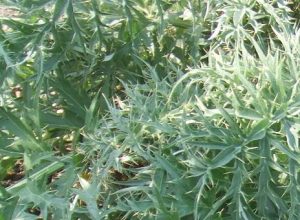WP5 aims to identify and characterize high-added value compounds from cardoon leaves.
Task 5.1 Proteases from leaves and vegetable rennet.
Proteins extracted in WP1 will be assayed for their proteolytic activity and tested for milk clotting.
Task 5.2 Isolation of bioactive compounds.
A deep chemical analysis on leaves extracts received by WP1 were done. The aim of the analysis was to understand the composition of SSCO2 extracts in comparison to Naviglio and batch extracts, with particular attention to cynaropicrin content. The extracts from Naviglio technology are characterized by the presence of fatty acids and a good percentage of cynaropicrin, being the best sample in term of content of cynaropicrin. However, with the Naviglio technology it is possible to extract only cynaropicrin, as sesquiterpene lactone. Differently, with the batch method it is possible to extract also another sesquiterpene lactone: the grosheimin. In fact, in other samples it is possible to see the presence of this sesquiterpene lactone. From all the data, the content of cynaropicrin is higher in samples from Novamont plantation than Sant’Agata plantation.
Even if with SCOO2 the extraction of cynaropicrin is lower, it is possible to extract another sesquiterpene lactone: the 11,13-dihydroxy-8-desoxigrosheimin. With this type of extraction waxes are also extracted. In fact, the signals of waxes in GC-MS chromatograms are more evident in MS than in the samples extractes with Naviglio technology.
In all the samples it is possible to see, both with NMR and GC-MS analysis, the presence of fatty acids and other triterpenes, such as squalene, or pentacyclic terpenes, such as lupeol.
